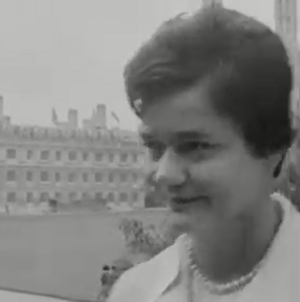Elizabeth Laverick facts for kids
Quick facts for kids
Elizabeth Laverick
|
|
|---|---|

in 1967 during a BBC interview
|
|
| Born | 25 November 1925 Amersham, Buckinghamshire, England
|
| Died | 12 January 2010 (aged 84) |
| Nationality | British |
| Alma mater | Durham University |
| Awards | OBE (1993) |
| Scientific career | |
| Fields | Engineer |
| Institutions | Elliot Automation Institution of Electrical Engineers Women's Engineering Society |
Elizabeth Laverick (born November 25, 1925 – died January 12, 2010) was a super smart British engineer. She broke many barriers for women in science and engineering. Elizabeth became a technical director at Elliott Automation Radar Systems. She was also the first female deputy secretary of the Institution of Electrical Engineers (now called the Institution of Engineering and Technology). She even led the Women's Engineering Society as its president.
Elizabeth Laverick was the first woman to earn a PhD in a science subject from Durham University. For her amazing work, she received an OBE award in 1993. This award is a special honor from the British government.
Contents
Early Life and Her Amazing Education
Elizabeth Laverick was born in Amersham, England, in 1925. Her dad was a chemist, and her mom helped him with office work. Elizabeth went to Dr Challoner's Grammar School. There, she studied physics, math, French, and English.
After finishing school, she worked as a technical assistant. This was at the Radio Research Station in Ditton Park. In 1943, Elizabeth started studying radio and physics at Durham University. She loved learning so much that she stayed to get her PhD. She researched how electricity behaves in certain materials. In 1950, she made history by becoming the first woman to get a science PhD from Durham University!
A Trailblazing Engineering Career
After her PhD, Elizabeth worked as a research assistant at Durham for a year. Then, she joined GEC Stanmore (which is now Marconi Defence Systems Ltd.). She worked there as a microwave engineer. Microwaves are a type of radio wave used in things like radar and communication. At that time, there were only a few women engineers and scientists at GEC Stanmore, among hundreds of men.
Leading the Way in Radar Technology
In 1954, Elizabeth moved to Elliott Automation. She gained lots of experience working with microwave instruments. By 1957, she became a senior engineer. In 1959, she was put in charge of the radar and communication research laboratory.
Later, she became the technical director of Elliott Automation Radar Systems. This was a huge job! She was in charge of making sure that four different departments created high-quality radar and other products. Many of the products she worked on, like airborne radar for planes and radar for the army, were successfully produced.
Elizabeth moved from doing technical work to a management role. In 1968, she became the general manager of Elliott Automation Radar Systems. She showed everyone that women could be great leaders in engineering!
Supporting Women in Engineering
Elizabeth Laverick was very passionate about helping other women. From 1967 to 1969, she was the president of the Women's Engineering Society (WES). She spent her free time talking to girls about careers in engineering. She wanted to inspire more young women to join the field.
She joined WES in 1959. She also edited the WES magazine, The Woman Engineer, from 1983 to 1990. In 1984, she became a Vice President of the Electrical Association for Women.
In 1971, Elizabeth made another big career change. She became the first female deputy secretary of the Institution of Electrical Engineers (IEE). She held this important role for 14 years!
Elizabeth was one of the first women to become a Fellow of the IEE. She was also a Fellow of the Institute of Physics. She led the Institute of Physics' 'Women in Physics Committee'. She was also the first woman to be on the IEE Council. In 1993, she received an OBE award for her amazing work in supporting women in engineering and science.

